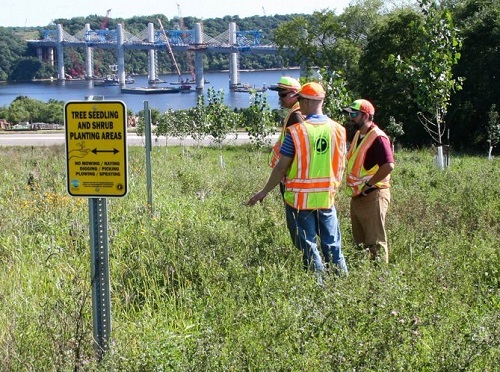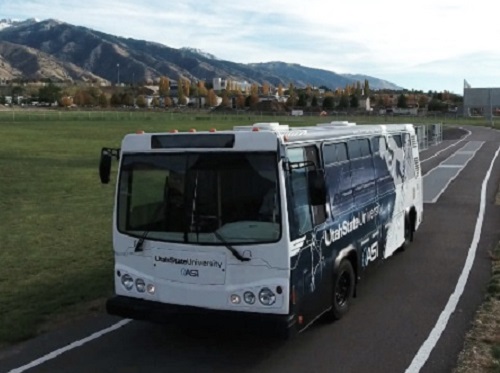A team of University of Minnesota researchers recently wrapped up a study that examined the effectiveness of “revegetation” efforts following the conclusion of infrastructure projects statewide. That study also compiled “best practice” recommendations to transportation departments and roadside management organizations regarding post-project efforts to create pollinator-friendly habitats.
[Above photo by the Minnesota DOT]
The study – sponsored by the Minnesota Department of Transportation and the Minnesota Local Road Research Board – examined how transportation agencies “revegetate” roadsides after construction projects to provide road stability, storm water filtration, and visual appeal. Revegetation is also a good opportunity to create pollinator-friendly habitat. However, planting and maintaining ditches can be expensive, funds for such projects are usually limited, and there isn’t much data on which methods actually work, the researchers found.
“This project will help agencies across the state refine the seed mixes they use with substantial benefits to pollinator habitat,” noted Dan MacSwain, natural resource coordinator for Washington County Public Works and the technical liaison for this project, in a blog post. “It will also produce cost savings.”
A key part of the study measured the presence of bumblebees and flowers in roadside ditches and generally found a positive link between the two – suggesting that greater flower diversity promotes stronger pollinator populations. That portion of the study also found that bumblebees are more prolific in roadside ditches where the surrounding landscape is also pollinator-friendly; suggesting that ditches alone cannot fully meet the habitat needs of insects, Snell-Rood emphasized, meaning roadside restoration efforts can generally perform better if they’re located near already-established pollinator habitat.
The insects that the survey studied – bumblebees and butterflies – showed a ready willingness to use non-native flowers for food. However, the study also points out that these insect groups are “generalists” and this amenable to feeding on a wide variety of flowering plants. That means revegetating ditches with non-native plants will not support more specialized pollinators – ones that need specific, native flowers to survive, the researchers found.
“Our results suggest that roadsides could be managed with a ‘more flowers everywhere’ strategy without raising costs,” added Emilie Snell-Rood, associate professor with the University of Minnesota’s Department of Ecology, Evolution, and Behavior and the principal investigator for the project. “[However] the ‘set it and forget it’ approach to native roadside revegetation efforts is insufficient if long-term establishment of native plants is the goal.”
For generalized, pollinator-friendly revegetation practices, the researchers recommended using an inexpensive, non-native seed mix – such as alfalfa, red clover, or white clover – mixed in with a handful of native species proven to be good at establishing themselves, such as wild bergamot, field thistle, goldenrod, and common milkweed. However, if the goal is to conserve a particular species, the roadside will need to be tailored to that species’ plant food needs.
“Our results overall suggest roadside management for natives and pollinators requires some discussions within agencies and management organizations about primary goals,” Snell-Rood said.
State departments of transportation across the country have been heavily involved in a wide array of pollinator specie preservation and growth efforts over the years.
For example, in 2021, the Georgia Department of Transportation and the Georgia Association of Conservation Districts installed 15 pollinator habitat sites in designated locations as part of a joint effort to educate state residents about the important role “pollinators” such as bees, butterflies, and other insects play in Georgia’s agricultural sector.
Out west, the Texas Department of Transportation has been working for several years to make the state’s bridges and related infrastructure more hospital to bats, especially as the nocturnal flying rodents help to naturally suppress the insect population without the use of pesticides while acting as pollinators to assist in flowering plant reproduction.
Meanwhile, the Tennessee Department of Transportation, along with the Tennessee Department of Environment & Conservation and Tennessee Department of Agriculture, formed a partnership in 2019 to support 64 acres of “pollinator meadows” at eight state parks. Each blooming meadow contains a mix of nectar-bearing plants and milkweed, which sustain pollinators such as bees, moths, butterflies, birds, and small mammals such as bats.
And in in March 2020, the American Association of State Highway and Transportation Officials sent a two-page letter to the U.S. Department of the Interior supporting “expedited approval” of the voluntary national Candidate Conservation Agreement with Assurances or CCAA to further encourage the creation of pollinator habitats in highway rights-of-way.
The CCAA – eventually finalized in April 2020 – provides a “huge boost” for the conservation of Monarch butterflies and other pollinators on a landscape scale, the U.S. Fish & Wildlife Service noted at the time.


